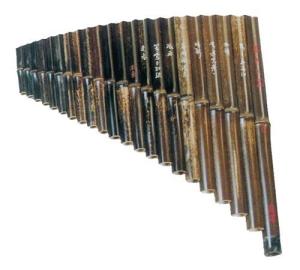Sharing of easy ways to eliminate depression
There are many materials for making panpipes, such as bitter bamboo, thin bamboo, ebony, sandalwood, mahogany, rosewood, cherry wood, serpentine wood, rosewood, ceramics, glass, carbon fiber, glass fiber, acrylic, ABS plastic, copper Pipes, steel pipes, etc. Commonly used are bitter bamboo, various wood, carbon fiber, plastic.

Different panpipes have different connection methods due to different materials and types. Some are fixed with ropes and bamboo grate pieces, some are inlaid with wooden frames, some are glued together, and some are fixed with bases. Some plastic panpipes are integrated, and are formed at one time during processing.
The steps of making a pan flute are divided into the following steps:
- Every year, I go to various bamboo production areas in China to select bamboos one by one (five years of bamboo age).
- It is transported back to the panpipe factory to select materials again, and the bamboos that fail to pass the test are eliminated. The remaining bamboos are graded according to entry, performance, and master. They are sawed into roots according to specific lengths and baked straight, and they are removed from mildew and moth and stored in the bamboo warehouse.
- Pipe material selection and measurement of fixed length: a standard panpipe should be from long to short in length from bass to treble, and pipe diameter should be from thick to thin. Those that do not meet this rule cannot be considered a good panpipe.
- Planing: Plane each of the prepared set of pipes to facilitate the next step to stick the pipes.
- Sticky pipe: Use imported glue to bond the pipe to the pipe. For example, the panpipe glued with ordinary woodworking glue is not strong.
- The Romanian pan flute needs to make a base to ensure the firmness of the pan flute. The base is the most complicated process, so the price of the Romanian pan flute is relatively high. The place where the upper end of the base and the bamboo pipe are connected should be completely fitted, otherwise the use of the base will be useless. There is no need to make a base for the Chinese pan flute, the disadvantage is that it is easy to be crushed.
- Grinding: Repeated grinding to form a smooth mouthpiece. A good panpipe should not grind the mouth, and a good mouthpiece should be smooth and should not have any shape of edges and corners. Preliminary sanding of the bamboo tube and base for the first painting.
- Spray paint: A panpipe is usually sprayed with thin paint 1-3 times according to the style. The quality of the paint affects the health of the user, and the green paint is the best. Painting is cost-effective, but it is easy to brush unevenly, and some places are thick and some places are thin, which affects the sound quality.
- Tuned, marked factory.
For the wooden panpipes, a professional lathe is used to turn the pipes into wooden pipes according to the standard size, and the subsequent steps are the same as those for the bamboo panpipes.
 渝公网安备 50010702504639号
渝公网安备 50010702504639号